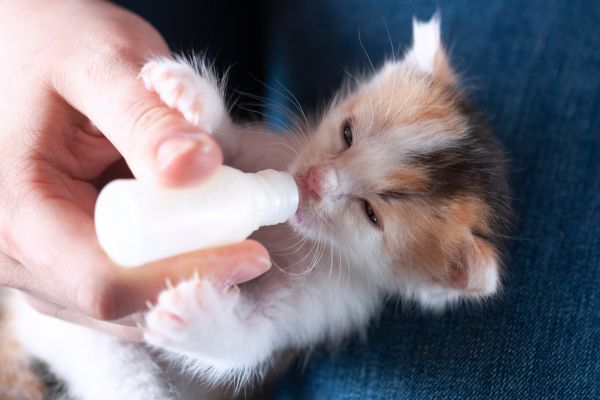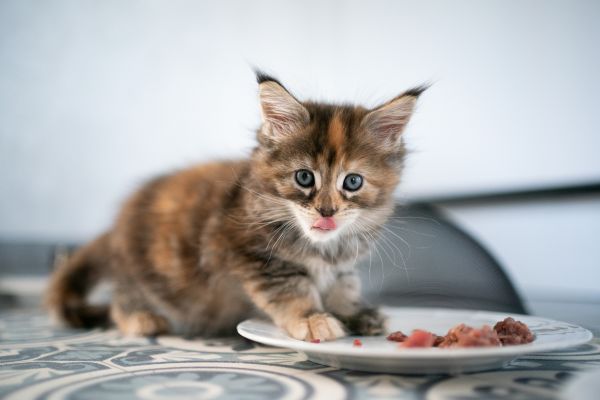Kitten season is fast approaching, and with it comes an influx of baby cats that need to be cared for. Whether you’re a cat owner with a pregnant feline that’s about to give birth or a foster parent that’s assigned to look after orphaned kittens, knowing what you should feed baby cats during this crucial stage can help increase the likelihood of their overall development.
In this Waldo’s Friends article, we discuss:
- What is a kitten and what are her needs?
- How often should kittens eat?
- What can kittens eat?
- Can I feed regular cat food to kittens?
What is a kitten and what are her needs?
A baby cat is called a kitten from birth until she turns six months old. She can be born with one to four other kittens in a litter—all of whom are tiny, helpless, and fully reliant on their mother. During the first few days, newborn kittens cannot urinate, defecate, and regulate their own temperatures. Moreover, they are unable to see, hear, and walk.
Because of their inability to do things in the first few weeks of their lives, kittens need a steady source of nourishment as well as a safe and stable environment. Queens or mother cats should be able to provide these to their young, but if they cannot for some reason, an experienced carer should attend to their needs. The task includes regularly feeding cats through a nursing bottle or syringe, stimulating them to pee and poop, as well as keeping them warm.
TIP: Do you suspect your cat is pregnant? Read this blog post to discover the telltale signs. If she is, help ease her pregnancy through four simple ways.
How often should kittens eat?
Kittens have different recommended feeding frequencies based on their age:
- Newborn to 1 week old: Every 2 to 3 hours
- 2 weeks old: Every 3 to 4 hours
- 3 weeks old: Every 4 to 6 hours
- 4 weeks old: Every 5 hours
- 6 weeks old: Three or more feedings evenly spaced out throughout the day
- 12 weeks old: Three feedings evenly spaced out throughout the day
A healthy kitten’s initial weight typically ranges from 80 to 120 grams. She should gain at least seven to 10 grams a day, and about 100 grams per week over the first six months. Monitor her daily weight, food intake, and other milestones, so you can discuss her progress with the veterinarian. A lack of growth in body size can be an indicator of illness.
What can kittens eat?
Cats are obligate carnivores that eat food high in animal meat and low in carbohydrates. But as kittens, these growing creatures need sustenance packed with fat and protein. Protein, fat, amino acids, and essential fatty acids assist with healthy tissue growth. Meanwhile, calcium and phosphorus can help her teeth and bones grow properly. Vitamins A, B, D, and E are also needed by kittens to support their various systems.
Mother’s milk
Kittens start off by drinking their mother’s milk. The colostrum, or the milk from a nursing cat’s first few days, is not only high in protein. It also contains nutrients that can strengthen the litter’s immune system and protect them from future diseases.

Kitten glop
A cat milk substitute, warmed kitten glop is usually given to baby cats whose mothers cannot nurse or unfortunate ones that have been orphaned. This special kitten supplement formula is not the same as cow’s milk, which contains less protein. In addition, other milk alternatives (whether from plants or other mammals) should not be given to kittens.
TIP: Learn how to make homemade kitten glop through our blog post.
Wet kitten food
When they reach the four-week mark, healthy kittens can be slowly weaned off their mother’s milk or kitten glop and start eating wet food made just for kittens. Food and clean drinking water should be provided at all times throughout the weaning stage.
To help kittens learn how to eat, you can first try offering the milk formula in a spoon. Then, move on to a saucer. Gradually adjust the ratio of the milk with the canned food by slowly increasing the latter’s portions. Make sure your kitten’s stomach suits the new food by checking for loose stools or diarrhea.
Prevent your kitten from overeating and vomiting her food by adjusting the serving portions based on her size, needs, and activity levels. VCA Animal Hospitals recommends splitting her daily food allowance into three to four or more smaller portions, especially since her tiny stomach can only hold small amounts.

Dry kitten food
Dry kitten food can also be included in a young cat’s diet by the time she’s seven weeks old. However, this option may have more calories and less flavour, protein, and moisture content than canned food.
By the time they’re six months old (26 weeks of age), kittens should be at 75% of their adult size and only fed meals twice a day. Adult food can be slowly introduced when your cat is 8 to 10 months old. Avoid grazing or free feeding in adult cats so they don’t suffer from health complications such as obesity, kidney disease, and urinary tract issues.
Can I feed regular cat food to kittens?
All cats need to eat “complete and balanced meals” to maintain their health and well-being. But because kittens grow rapidly, they need specially formulated meals that can support their nutritional needs. These requirements may not be provided by cat food made specifically for other age groups.
Kittens that feed on cat food for adults or seniors may experience severe and irreversible effects. Aside from not achieving their ideal height and size, they may gain unnecessary weight and suffer from gastrointestinal issues.
Always remember…
Cats are different creatures from humans and dogs, so they can’t automatically eat what you or your canine pet is having. However, there are some safe meat, seafood, fruit, and vegetable options that can be given to them as occasional treats.
Consult with your veterinarian before introducing new food, and select healthy options that will benefit her growth.
Leave a comment
Your email address will not be published. All fields are required.